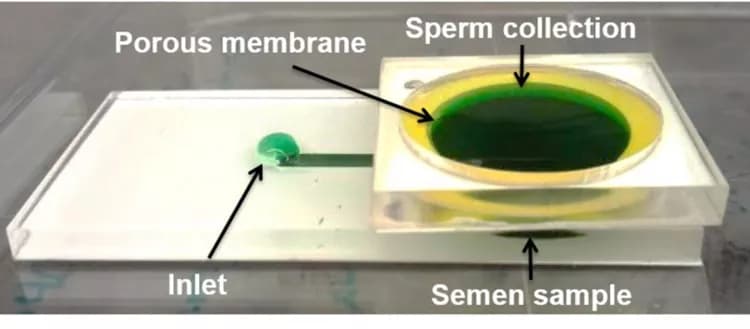
Survival Of The Fittest Sperm: How New Technology May Help Infertile Couples
The competition is fierce and only the strongest survive the obstacle course within the female reproductive tract. Of the millions of sperm that enter the vagina, only about 10 or so make it to the oocyte or egg, demonstrating how rigorous the natural sperm selection process really is. So how is it possible to select only the best sperm for assisted reproductive technologies such as in vitro fertilization? That's what a researcher at Florida Atlantic University is aiming to do with his microfluidic technology for reproductive medicine.
Worldwide, nearly 48.5 million couples have been unable to have a child after trying for five years or more. While in vitro fertilization, intrauterine insemination, and intracytoplasmic sperm injection have been effective treatment options for infertile couples, only about one-third of these methods result in live births.
Male infertility accounts for about 30 to 50 percent of all infertility cases, and infertile men tend to have abnormal sperm characteristics such as low sperm concentration, poor sperm movement, abnormal shape and size, and high levels of damage to the DNA.
"DNA damage is one of the more important characteristics of sperm, because higher levels of damage are associated with lower pregnancy rates, early loss of pregnancy, and increased disease rates of offspring who are conceived through assisted reproductive technologies," said Waseem Asghar, Ph.D., assistant professor in the Department of Computer and Electrical Engineering and Computer Science, and the Department of Biological Sciences at FAU. "That's why it is so important to develop methods to select the healthiest sperm for assisted reproductive technologies."
The most commonly used or conventional method for assisted reproductive technologies involves a technique called centrifugation. This technique spins the sperm samples around quickly, and at the end, the most motile sperm are used for reproductive medicine. Although this method is efficient at selecting motile and morphologically normal sperm, the process is problematic because it tends to increase levels of certain chemicals that cause DNA damage. This technique also is less efficient at selecting mature sperm or getting rid of sperm that are near death.
There are alternatives to centrifugation such as microfluidic technology, which has been widely studied for various applications in biological and chemical analysis, point-of-care testing and diagnostics, and clinical analysis. Asghar is currently working on developing easy-to-use and inexpensive sperm sorting devices that have applications in intrauterine insemination, intracytoplasmic sperm injection, and in vitro fertilization.
"Microfluidic based technologies have surfaced as a novel substitute to conventional methods that use centrifugation," said Asghar. "These are devices that use small volumes of fluid, can enable more control to precisely sort cells within small volumes, and are created to mimic what happens naturally in the female genital tract. Sperm sorting methodologies based on microfluidic procedures are a valuable option since these techniques eliminate the damaging centrifugation steps."
Asghar's device consists of one inlet for the injection of a raw unprocessed semen sample and two plastic chambers separated by porous membrane. The most healthy and motile sperm swim through the porous membrane leaving behind less functional and dead sperm in the bottom chamber. Using this sorting technology, a technician just has to inject the semen sample into the device and can then collect healthy sperm from the top chamber in about 30 minutes, making it very easy to use.
Prior studies of microfluidic devices have shown that motility of the sperm sample increased to almost 100 percent and morphology of the isolated sperm also was improved after microfluidic sorting. And compared to other techniques used for assisted reproductive technologies, the use of the microfluidic device resulted in significantly lower rates of DNA damage and improved sperm recovery using this method.
"Sperm separation techniques should be quick, easy, low-cost, and have the ability to select motile and morphologically normal sperm while decreasing damage done to sperm DNA," said Asghar. "Since centrifugation tends to increase DNA damage, it should be avoided. Future studies should focus on creating sperm selection devices that can improve pregnancy outcomes and reduce birth defects."
The above post is reprinted from materials provided by Florida Atlantic University. Note: Materials may be edited for content and length.
Disclaimer: DoveMed is not responsible for the adapted accuracy of news releases posted to DoveMed by contributing universities and institutions.
Primary Resource:
Rappa, K. L., Rodriguez, H. F., Hakkarainen, G. C., Anchan, R. M., Mutter, G. L., & Asghar, W. (2016). Sperm processing for advanced reproductive technologies: Where are we today?. Biotechnology advances.
Related Articles
Test Your Knowledge
Asked by users
Related Centers
Related Specialties
Related Physicians
Related Procedures
Related Resources
Join DoveHubs
and connect with fellow professionals

0 Comments
Please log in to post a comment.